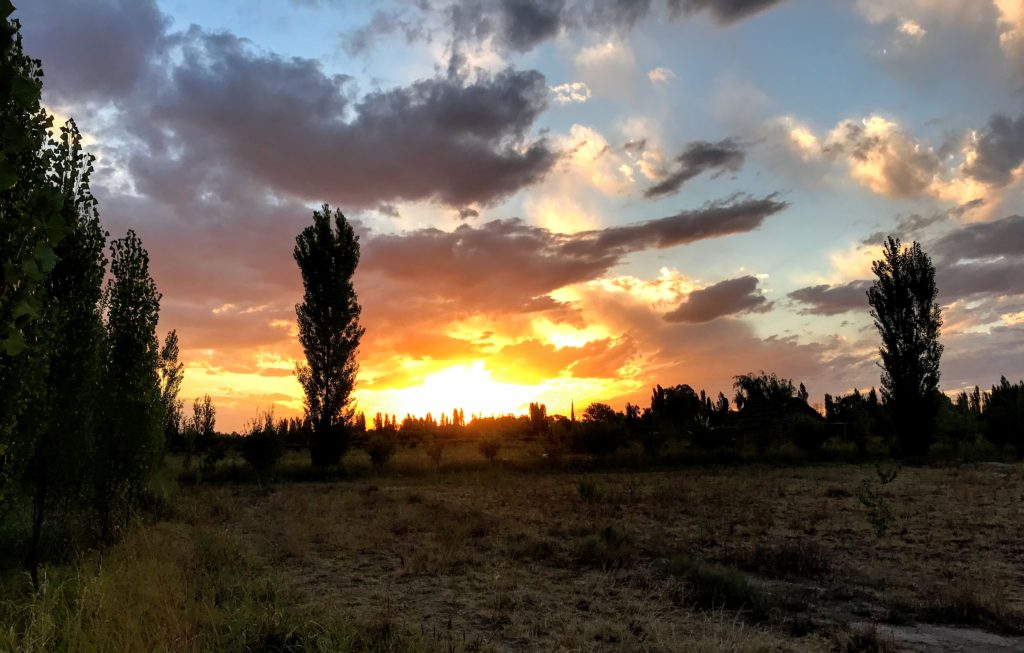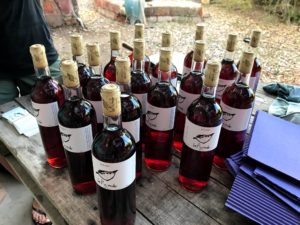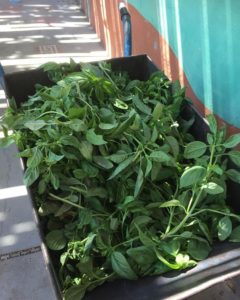Have you ever wondered what it would be like to live on a small farm and produce artisanal wine? We spent the last four weeks living on tiny Finca La Rosendo just outside of San Rafael, in Mendoza province in western Argentina (www.fincalarosendo.com.ar or Finca.LaRosendo on Facebook). Vicky and Alejandro (Ale) moved here from Buenos Aires fifteen years ago, attracted by the farm’s 10 acres of established vines (mostly Syrah and Criollo red, and Pedro Giménez white) and the opportunity to live in accordance with their values. They are social activists and pioneers in Argentina’s agroecology and natural wine movements. We met Ale only briefly as he was away until the last day of our stay on the farm, but we enjoyed getting to know Vicky and had fascinating wide-ranging discussions while working together in the vineyard and winery and over many shared meals and bottles of natural wine.

You may be asking, “what is natural wine?” While there is not a universally accepted definition or certification process, there seem to be some common attributes of wines generally considered natural. First of all, the grapes themselves are organic. That means no chemical fertilizers or herbicides to control weeds; for the first couple of weeks until a small tractor came through the vineyard we plunged through knee-high grass and weeds to harvest the grapes. Second, there are no additives in the winemaking process — no sulphites, often used as a preservative, nor added sugars or yeast. External flavors (including oaky barrels) are also a no-no. And third, no caustic cleaning agents are used to sterilize any of the equipment or bottles. Vicky argues that the wine should also be made and bottled on the farm by those who harvest the grapes, and it should be sold as directly as possible to the ultimate consumer, with few intermediaries.
One of the things we loved about the artisanal process was that we could do so much of it with our own hands and feet. The grapes were gorgeous and working with them is a very tactile experience. Only two machines were used in the process: a rickety old Peugeot pickup truck that Vicky used to haul the harvest from the vines to the farmhouse, and a small mill into which we slowly dropped grape bunches to remove the fruit from the stalks and stems. While the mill works well, we still had to sort through the the grapes by hand to remove any remaining stems. Mostly we worked with small Syrah grapes which didn’t need stomping, because the skins are fermented along with the grapes. But when we made white wine or rosé, or when we harvested Criollo grapes that are too large for the mill, we stomped the grapes with our feet. That was fun! And yes, we washed our feet beforehand, and after!


After the grapes are removed from their stems, they are fermented in large vats. One of my regular tasks was to open the vats and mix the fermenting liquid and solids (skins and seeds) three times each day with a large wooden paddle. The Spanish verb for this mixing process is “bazuquear,” and we dubbed the paddle my “bazuki,” though it’s really called a “bazuqueador.” I loved the physicality of the task and that I could literally feel the grapes fermenting. For the first few days after filling a vat it was hard to push the bazuki through the thick crust of grape skins that rise to the top. But day by day it got easier to stir the mixture as the skins broke down. The juice also darkened to a rich red, and I would begin to smell the alcohol. Once the sugars have completely converted to alcohol, it’s time to remove the mixture from the vats and press and strain it so that only the liquid goes into barrels to age until next year. Because La Rosendo produces natural wine, the barrels are made from hard plastic rather than oak both to avoid the external flavors of the oak and because wood is porous and would require cleaning with caustic agents. We emptied several barrels from last year’s harvest into wine bottles that we then corked and labeled for sale over the next few months. Although the wine produced from this year’s harvest won’t be ready until next year, I’m glad to say that we got to complete the cycle by drinking some of the wine from last year’s harvest. It was terrific!
While harvesting grapes and making wine was the main event during our stay, there were lots of other things to do on the farm. We helped Diego and Angie, who are friends of Vicky and Ale, make juice from pears, apples, and grapes. They made almost 3,000 liters of juice, and will take half of it to their home in Rosario, Argentina, where they will sell it in Diego’s natural food store. The other half will be sold locally by the farmers who provided the fruit. Just at the end of our stay, Vicky’s partner Yan made a small batch of beer (not for sale) from the farm’s own hops, and we harvested lots of plums, which Vicky made into a delicious chutney. This is a good time to mention that, in addition to working non-stop to get everything done during the busy harvest season, Vicky is a fabulous cook!
Lest you think this was a relaxing bucolic experience, let me say that we worked very hard, and the manual labor was physically tiring and often painfully repetitive. Monday through Friday were long work days, and we worked Saturday mornings as well. On the days we harvested grapes (about half the time), we would get into the vineyard shortly after dawn to take advantage of the cool morning temperatures. It would take about three hours to fill 20 crates with grapes, with the group working on two rows at a time clipping grape bunches to fill small buckets that we’d carry back to the pickup truck at the edge of the field and empty into the crates. By 10am, the day would be getting warm, and Vicky would drive the pickup truck with loaded crates to the work area adjacent to the farmhouse. After a quick breakfast (usually homemade bread, jams from the farm, and local honey), we’d work for another 2-3 hours to separate the grapes from the bunches and get them into a vat to start fermenting. Then lots of cleanup and lunch at about 2pm. By now it would be hot, and most people took a siesta after lunch before starting work again at 5pm. In the shorter late afternoon work period, we would clean bottles, move aging wine between barrels to reduce sediments before bottling, fill and cork bottles, attach labels and put the bottles in boxes for sale, etc. Or we would do something else on the farm that had nothing to do with winemaking — harvest plums, basil, or tomatoes; remove debris from irrigation ditches (yuck! It’s amazing what trash comes into the farm via the open irrigation channels); or collect firewood for the outdoor oven. We’d take a cold outdoor shower just before sundown and then prepare dinner together at about 9pm. We were glad to take a backseat to other great cooks who were less intimidated by cooking with the kitchen’s relatively primitive cooking equipment. On some hot days when we all craved a cold beer, I’d borrow Vicky’s bike to ride almost two miles over dirt roads to the nearest “store” and bring back a few large bottles for the group.
Vicky and Ale have been accepting volunteers for several years through www.wwoof.org or www.workaway.info. In fact, they hire very little labor on the farm, relying instead on volunteers or exchanges with friends like Diego and Angie who came to help with the grape harvest while collaborating with a few local farmers to make pear, apple, and grape juice. Coincidentally, Diego (and his friend Filippo, who is traveling in South America and volunteered on the farm for a couple of weeks) grew up in Padova, Italy, which is very close to where I’ve been going for my annual bike trips over the last fifteen years. Other volunteers who overlapped with us came from Brazil (Connie), The Netherlands (Karel), and France (Manon and Victor) — quite an international crew and all fun and interesting people!
Our last night on the farm coincided with Finca La Rosendo’s annual harvest celebration. Vicky and Ale invited their friends, many of whom also moved to Mendoza province from Buenos Aires over the last several years. We had already met Alejandro and Monica, recent arrivals who are producing tasty extra virgin olive oil. Vicky is a great tango dancer, and she invited friends from her “milongo” in San Rafael. A few of her friends are great musicians, and Vicky told them that Lorrie plays piano. So two weeks before the party, Vicky’s friends Gasti and Guille brought their guitar and trumpet to the farm to jam with Lorrie on Ale’s dusty electronic keyboard. Gasti brought some sheet music for Argentine folk music and jazz standards (just chord changes, the melody line, and lyrics) that they could play together at the party. Lorrie was both excited and terrified about performing for a big party. But she survived it, despite the fact that she had never heard the songs before, her fellow musicians were giving her cues that she could not always hear or understand, and the lighting was terrible (I helped on this last issue by standing near her with my iPhone flashlight). The other musicians (there were several!) were very talented and enthusiastic and gracious. Lorrie even whipped out her harmonica at one point! She was totally exhausted the next day and not sure whether she’d pulled the whole thing off or not (she is always her own harshest critic). But she did! People were dancing tango, singing along, and having a great time. It was terrific, and I have a couple of iPhone recordings to prove it! The bonfire went on until 5am, but we only lasted until a bit past 3.

We learned so much on the farm and found Vicky’s passion and commitment inspiring. It was exciting to witness the burgeoning agroecology and organic foods movement in Latin America. We saw many things we’d like to do ourselves–and other things we definitely won’t do! The experience gave us much to think about as we contemplate settling down again somewhere someday.
We are taking a brief city break in Santiago, Chile, before heading to northern Chile and Peru. We hope to blog again before we start the Inca Trail to Machu Picchu on April 4.
Sending lots of love to everyone–we love reading your comments and emails and hearing what you’re up to!







Great to hear from you again, folks. Marta and I are doing quite well, thankfully, in spite of the craziness around us. You escaped at the right moment! We’re off to Cyprus for a month in April to observe peace dialogues. Weill tell you how it goes. Abrazos to you both, Ramon and Marta
Hi Ramon. Glad to hear you and Marta are well. We’re in Santiago for a few days, and I’ve thought of you often. We went today to the sobering museo de memoria y derechos humanos. Abrazos amigos.
You both are experiencing joys that the rest of us back up here can only envy.
For most of us, it is back to the mob of commuters living under an incompetent bully who appears to be giving the rest of the world notice to evacuate.
We can only enjoy your experiences vicariously while watching the snow fall on the first day of spring in the Northern Hemisphere.
Muchas gracias por sus noticias.
Betty and Norman
What a treat to enjoy your blog! It is a welcome relief from daily horrors we have here. The Republicans have adopted the boorish immorality of their leader and the corporations all seem to be dishonest. As my friend from Mendoza likes to say “¡Qué macana!”.
Hi George. I’m such a news hound that I never thought I’d say that it’s been nice to be disconnected this last month without internet except when we went into the city. I’ve been reading actual books by Latin American authors instead: Gabriel García Márquez, Juan Rulfo, and Ernesto Sabato.